
Rhaenyra wanted to kill Aemond. Daemon wanted to kill a son. Oops! Poor Jaehaerys Targaryen, second of his name, enjoyer of piggyback rides.
With Jaehaerys’s death, House of the Dragon is back. Let’s break down the prequel’s Season 2 premiere, “A Son for a Son.”
Deep Dive of the Week: The Board Before Us
War between the blacks and greens is unfolding. And as HBO frequently reminded us before this season, all must choose a side in the conflict. So how is that shaking out in Westeros? Let’s take a look at the map.
Westeros is frequently called the Seven Kingdoms, but this is a misnomer—there are actually nine distinct regions (or 10 if you count what’s north of the Wall). In this episode, we heard a lot about which great houses were declaring for which side. Let’s start with Rhaenyra and the blacks.
Unlike his brother Lucerys’s journey, Jacaerys’s trip to gather strength for his mother’s cause was successful—for the most part. At the Eyrie, he earned the support of Jeyne Arryn by promising a dragon to protect the Vale. This was probably the easiest alliance to make—not only is Rhaenyra an Arryn (her mother was Aemma Arryn, though Aemma’s exact relationship to Jeyne is unknown), but Jeyne is herself ruling a region as a woman. Never married, the Maiden of the Vale virtually has to support Rhaenyra, lest her own claim to power come into question. Here’s how the Jeyne-Jacaerys scene (which I was hoping we’d see in the series) plays out in Fire & Blood:
“Thrice have mine own kin sought to replace me,” Lady Jeyne told Prince Jacaerys. “My cousin Ser Arnold is wont to say that women are too soft to rule. I have him in one of my sky cells, if you would like to ask him. Your Prince Daemon used his first wife most cruelly, it is true … but notwithstanding your mother’s poor taste in consorts, she remains our rightful queen, and mine own blood besides, an Arryn on her mother’s side. In this world of men, we women must band together. The Vale and its knights shall stand with her … if Her Grace will grant me one request.” When the prince asked what that might be, she answered, “Dragons. I have no fear of armies. Many and more have broken themselves against my Bloody Gate, and the Eyrie is known to be impregnable. But you have descended on us from the sky, as Queen Visenya once did during the Conquest, and I was powerless to halt you. I mislike feeling powerless. Send me dragonriders.”
The Vale is a powerful region. Remember, in Game of Thrones, the knights of the Vale saved Jon Snow at the Battle of the Bastards. But the Vale is also a mountainous region, and winter snows can close the passes into and out of the area. It’s currently autumn, so Jeyne will need to mobilize her forces quickly if she’s to help the blacks.
As for which dragon will head to the Eyrie to fulfill Jeyne’s request, that is left undetermined. Rhaenys is using Meleys to patrol more than 100 miles of ocean—the blacks’ dragons aren’t exactly in low demand.
In the North, Jacaerys confirmed the support of Cregan Stark. But Cregan had one eye on the Wall and the upcoming winter and pledged only a few thousand “graybeards,” though he said these “well-honed” men would “fight hard, like Northerners.” The North is the largest of Westeros’s regions, so it takes time for the Starks to mobilize their banners, especially when the weather is turning. And the North is remote—surely you haven’t forgotten how big of a deal it was in Game of Thrones for Robb Stark to cross the bridge at the Twins just to make it south and begin fighting. It’s for this reason that the North was largely spared during Aegon’s Conquest: By the time Torrhen Stark made it south of the Neck, Aegon had burned several other regions. Torrhen saw the destruction and submitted to the dragon king without fighting, earning himself the moniker “the King Who Knelt.” The North is a strong ally for Rhaenyra’s side but not one that can be relied upon quickly.
Finally for the blacks, while House Velaryon does not control a full region, Corlys’s navy is the mightiest in the realm. As he notes in this episode, his blockade of King’s Landing is nearly complete, which is already putting major stress on the city and the greens.
Shifting to the greens, their strength is focused in the South. Let’s start with Oldtown, where the Hightowers rule. Otto, Aegon II’s hand, is actually not the lord of his house—he’s a second son, and his nephew Ormund inherited power after Otto’s older brother, Hobert, died off-screen (Hobert is alive for the Dance in Fire & Blood, but an interview with showrunner Ryan Condal indicates that isn’t the case for the show). Obviously, Ormund has declared for the greens.
But the Hightowers, while a strong house, are not the Lords Paramount of the Reach. That’d be the Tyrells (you remember Margaery and Co. from Game of Thrones), and they have not declared for either side. In this era, the Hightowers’ strength and influence in King’s Landing mean they are sometimes called “over-mighty bannermen.” The Tyrells are technically in charge of the Reach, but the Hightowers may wield more actual power. In Fire & Blood, it is reasoned that “Lord Tyrell of Highgarden was a mewling boy in swaddling clothes whose mother, acting as his regent, would most like align the Reach with her over-mighty bannermen, the Hightowers.” But as of now, the Tyrells—and almost every other house in the Reach—are neutral.
In the Westerlands, the Lannisters rule. Tyland Lannister is Aegon II’s master of coin, and his twin brother, Jason, is the Lord of Casterly Rock. As Tyland notes in this episode, Jason is gathering his forces to mass at the Golden Tooth, which is in the easternmost area of the Westerlands, next to the Riverlands. As they were in Thrones, the Lannisters are one of the wealthiest houses in the realm (though Fire & Blood indicates that at this time, the Velaryons are wealthier) and are thus a very strong ally.
And of course, the greens won over Borros Baratheon and the Stormlands with Aemond’s marriage pact. That’s a big bummer for the blacks because Rhaenys is half Baratheon through her mother, Jocelyn Baratheon. But as we saw last season, Borros isn’t one to care about such things. The Baratheons aren’t quite as strong as they are in Thrones, when Robert Baratheon is literally king, but they are a great house, and the Stormlords are fierce. They are a strong ally for the greens and a huge loss for the blacks.
Still, many houses want nothing to do with this war. It’s been 130-some years since Aegon’s Conquest, and much of the realm still bears the scars of that dragon warfare. The Tyrells are not the only great house that is hesitant to declare for a side. The Riverlands are also staying out of it, at least for now. In the finale of Season 1, Daemon called the region “crucial.” Yet Lord Grover Tully is an old man—so old that he was at the Great Council of 101 AC, where he spoke in favor of Viserys’s claim to the throne. He favors the male claimant again … but his younger relatives and heirs aren’t so keen to fight in a war of dragons and are ignoring him. Here’s how Fire & Blood describes the situation:
Lord Grover insisted that Riverrun would fight for young King Aegon. Yet no such word went forth. The old lord was bedridden and would not live much longer, Riverrun’s maester had declared. “I would sooner the rest of us did not die with him,” declared Ser Elmo Tully, his grandson. Riverrun had no defense against dragonfire, he pointed out to his own sons, and both sides in this fight rode dragons. And so whilst Lord Grover thundered and fulminated from his deathbed, Riverrun barred its gates, manned its walls, and held its silence.
Dorne isn’t actually a part of the Seven Kingdoms at this point, having successfully held off the dragon kings in a series of bloody conflicts. The Dornish want no part in this war, either. “Dorne has danced with dragons before,” Qoren Martell tells Otto in Fire & Blood. “I would sooner sleep with scorpions.”
Finally, there are the Iron Islands. Maester Orwyle floated the idea of making Dalton Greyjoy, the young lord there, Aegon’s new master of ships in order to bolster the greens’ meager fleet, but nothing has come of it yet. As in Thrones, the Iron Islands boast a powerful navy, and the Greyjoys have a love of violence and chaos. But the Iron Islands are on the other side of the continent from King’s Landing, and it’s a long voyage around Westeros.
Got all that? Here’s how it looks visually:

But again, don’t be fooled by the geographical size of the blacks’ allies here. As noted above, the North and the Vale can be slow to mobilize, and some of Westeros’s wealthiest areas belong to the greens.
We’ll keep updating this map in future weeks as this war evolves.
Quick Hits
The Importance of Harrenhal
One more thought on geography and a castle that is quickly emerging as a strategic objective for both sides. In the Season 1 finale, Daemon mentioned that he wanted to establish a “toehold” in the Riverlands large enough to house a sizable host. In the Season 2 premiere, Aemond used the same word, “toehold,” also in reference to Harrenhal. It’s almost like Daemon and Aemond are mirror images of each other or something.
At any rate, Harrenhal is the place to be. It is currently under the control of Simon Strong, the great-uncle of Larys, though Larys is the Lord of House Strong. That would nominally put Harrenhal under the control of the greens … but with Larys away in King’s Landing, Fire & Blood explains that “the castle was but lightly garrisoned.”
Why is Harrenhal so important? It is, first and foremost, the largest castle in the realm. And while it never fully recovered from Aegon’s Conquest, when the dragon king melted King Harren Hoare’s castle with the fire from Balerion the Black Dread, it is still one of the realm’s most formidable fortresses. Harren intended to rule the Riverlands from that castle, and as such, it is centrally located, just north of the lake known as the Gods Eye. In more recent years, it was the site of the Great Council of 101 AC, as it was the only castle large enough to host so many lords and houses.
With Riverrun currently neutral, the greens’ forces are split. The Riverlands are right in the center of the continent and just north of King’s Landing, so securing them could allow the blacks to literally divide and conquer the greens or the greens to unite their regions and control the bulk of Westeros.
But why not just recruit the houses in the Riverlands as allies? The area is populated by a famously unruly bunch, with grudges that go back centuries. The Tullys are the Lords Paramount of the region, but houses such as the Strongs, Blackwoods, Brackens, and Freys—among many others—all have their own motivations and desires (and the trailers for Season 2 show the Brackens and Blackwoods in conflict). As such, this is a region that is perhaps best taken by force. Thus, Harrenhal is the perfect toehold for both sides.
Can the Kingsguard Fuck?
Whoa, Criston and Alicent! Given the way Alicent tells Criston that they should stop hooking up, it’s safe to say their activities would be looked down upon in Westeros. The dowager queen and the lord commander in bed together? Scandal!
But I wanted to find out: Is this affair strictly against the vows every member of the Kingsguard takes? And the answer, surprisingly, is that it probably is not.
In Season 1 of House of the Dragon, Criston laments that he broke his “oath of chastity” when Rhaenyra asks him to continue with their “arrangement.” But that’s the only reference to chastity that I can find from any knight of the Kingsguard. The “oath of chastity” is either Criston’s interpretation of his vows or a show invention—there’s no similar reference in the books.
George R.R. Martin doesn’t deliver the exact text of the Kingsguard vows, but we get many hints of them. The members of the Kingsguard “are forbidden to marry, to father children, and to hold land,” as Tyrion tells us in A Storm of Swords. That wording doesn’t forbid sexual liaisons. In A Dance With Dragons, Kingsguard knight Arys Oakheart tries to resist seduction from the Dornish princess Arianne Martell. “I swore a vow,” he starts to tell her, “not to wed or father children.” She says, smiling, “Well, I have drunk my moon tea, and you know I cannot marry you. Though I might be persuaded to keep you for my paramour.”
I’d wager that this apparent wiggle room is not an accident. Just as the men of the Night’s Watch are all but permitted to sneak down to Mole’s Town to sate their sexual appetites at the brothel there, most in the Red Keep would likely ignore similar activity from the white cloaks.
But let’s not mistake Criston for a strict rule follower. The best overview of the vows the knights in the Kingsguard make comes from Barristan Selmy in A Dance With Dragons:
The first duty of the Kingsguard was to defend the king from harm or threat. The white knights were sworn to obey the king’s commands as well, to keep his secrets, counsel him when counsel was requested and keep silent when it was not, serve his pleasure and defend his name and honor. Strictly speaking, it was purely the king’s choice whether or not to extend Kingsguard protection to others, even those of the royal blood. Some kings thought it right and proper to dispatch Kingsguard to serve and defend their wives and children, siblings, aunts, uncles, and cousins of greater and lesser degree, and occasionally even their lovers, mistresses and bastards.
This is pretty clear: The Kingsguard’s loyalty is to the king and the king alone. But recall how close Criston and Alicent were even back in Season 1—was he more loyal to King Viserys or the queen? Was he abiding by the spirit of these vows when he showed such favoritism to Alicent and such obvious animosity toward his king’s daughter?
I think Criston showed how unseriously he takes his oath after Viserys’s death. Lord Commander Harrold Westerling refused to take part in Otto’s suggestion that he go to Dragonstone and assassinate Rhaenyra, throwing down his cloak and saying, “I am lord commander of the Kingsguard. I recognize no authority but the king’s. And until there is one, I have no place here.” Criston, by contrast, killed the Rhaenyra-supporting Lyman Beesbury and drew his sword against his lord commander, saying he “will not suffer insults to her grace the queen.” That’s for sure not how a member of the Kingsguard is supposed to act.
(By the way, where is Westerling now? His character is long dead by this point in the books, so there really is no saying what the show has planned for him.)
So, the affair is new. But for Criston to take a loose interpretation of his vows and do whatever the seven hells he wants is not. And no matter what exactly he swore, the fact that the lord commander is getting it on with the dowager queen—the same queen who redecorated the Red Keep with Faith of the Seven heraldry!—is a huge mark of shame for the both of them. Especially since Criston should’ve been on duty.
The Strength of the Kingsguard
Speaking of Criston and his white cloaks, where the hell were they? How did they let two miscreants assassinate the heir to the throne?
The Kingsguard is typically made up of seven knights, and they rotate through shifts protecting the king and anyone else the king wants to protect (usually the royal family), as noted above. But with a civil war brewing, Aegon’s Kingsguard is down in numbers.
When Viserys died, Lorent Marbrand and Steffon Darklyn were already at Dragonstone, protecting Rhaenyra. You may remember how Daemon confirmed their loyalty at the end of Season 1 by threatening them with Caraxes. Then Erryk Cargyll famously broke with his twin, Arryk, to join Rhaenyra’s side as well, giving her three white cloaks. Since Harrold Westerling abdicated his role as lord commander once the greens moved to crown Aegon, that leaves just three members for Aegon’s Kingsguard: Criston, Arryk, and Rickard Thorne (whom we have yet to see on-screen). That’s a pretty light retinue for a king who is currently at war!
What’s more, for further defense of King’s Landing, the Iron Throne typically relies on the City Watch. Daemon gave this motley group its signature gold cloaks back in the series premiere, as he made a big show of rounding up criminals in Flea Bottom. That was decades ago, but many gold cloaks still have great loyalty toward Daemon, as his recruitment of one such soldier to assassinate a member of the royal family showed. Because of that allegiance, Aegon and the greens can’t pull from the City Watch to aid in their personal protection.
Add in the fact that Criston is shagging the queen, plus so many men are looking to the skies for dragons, and the Red Keep is very lightly defended.
Breaking Down the New Intro
We have a new intro for Season 2. Replacing the bloody family tree from Season 1 is this living tapestry, which rips through the history of the Targaryens in Westeros. It begins with a quick look at what I believe is old Valyria:
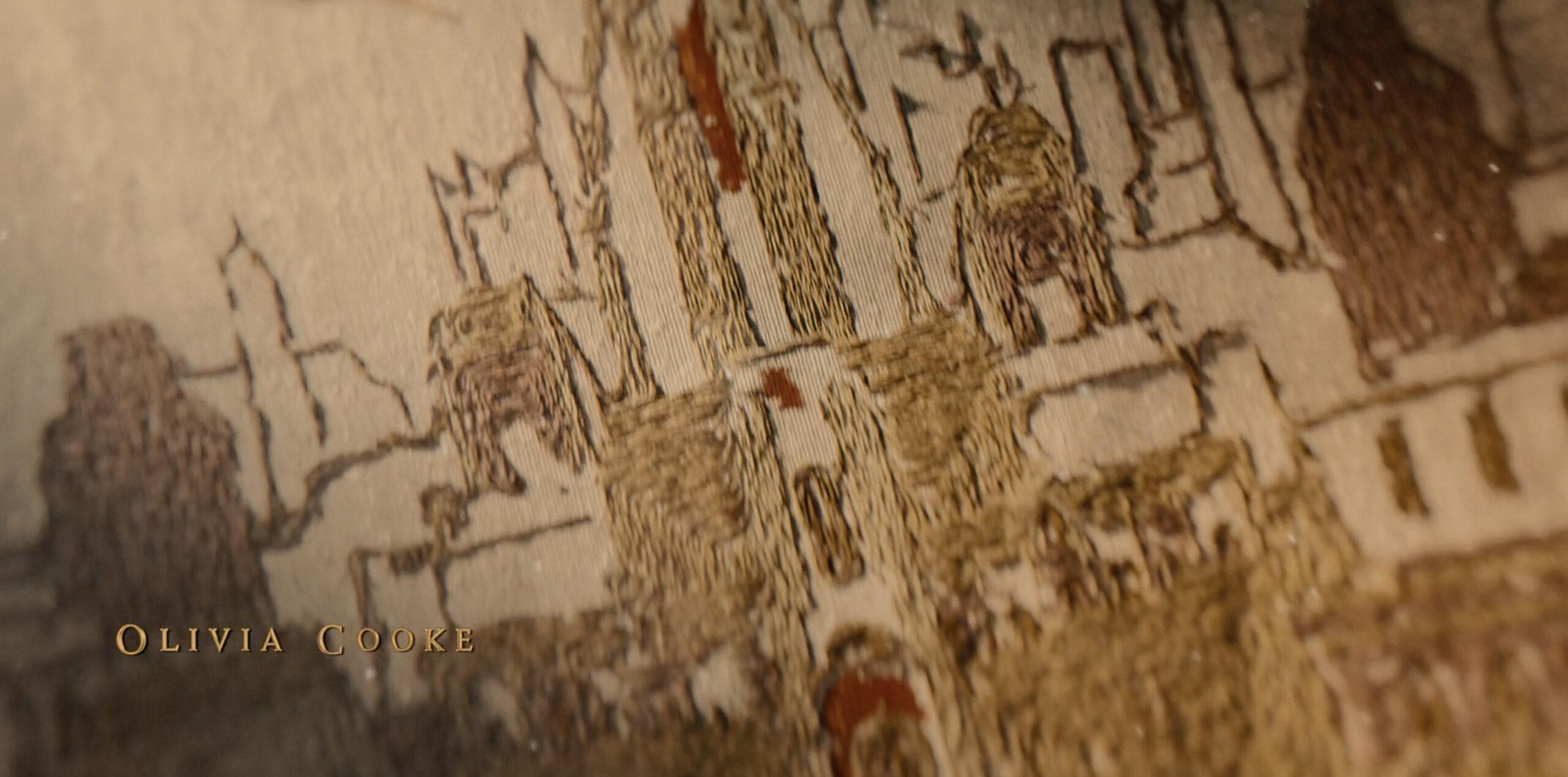
The blood running off of that structure toward a burning dragon appears to depict the mythical creation of dragons, which we know almost nothing about. Rumors say blood and/or fire magic was involved, which explains the imagery here.

This next scene may be a depiction of Azor Ahai—a legendary hero who had to stab a sword, Lightbringer, through his wife’s chest in order to infuse the sword with powerful magic and bring an end to the Long Night.

Here we have one Valyrian holding another. It could be related to the legend of Azor Ahai above, but it’s not totally apparent to me what this scene depicts.

Now things get more clear. Here’s a look at the Doom of Valyria, complete with exploding volcanoes and dying dragons:

Next up, Aegon the Conqueror and his two sister-wives flying their dragons:
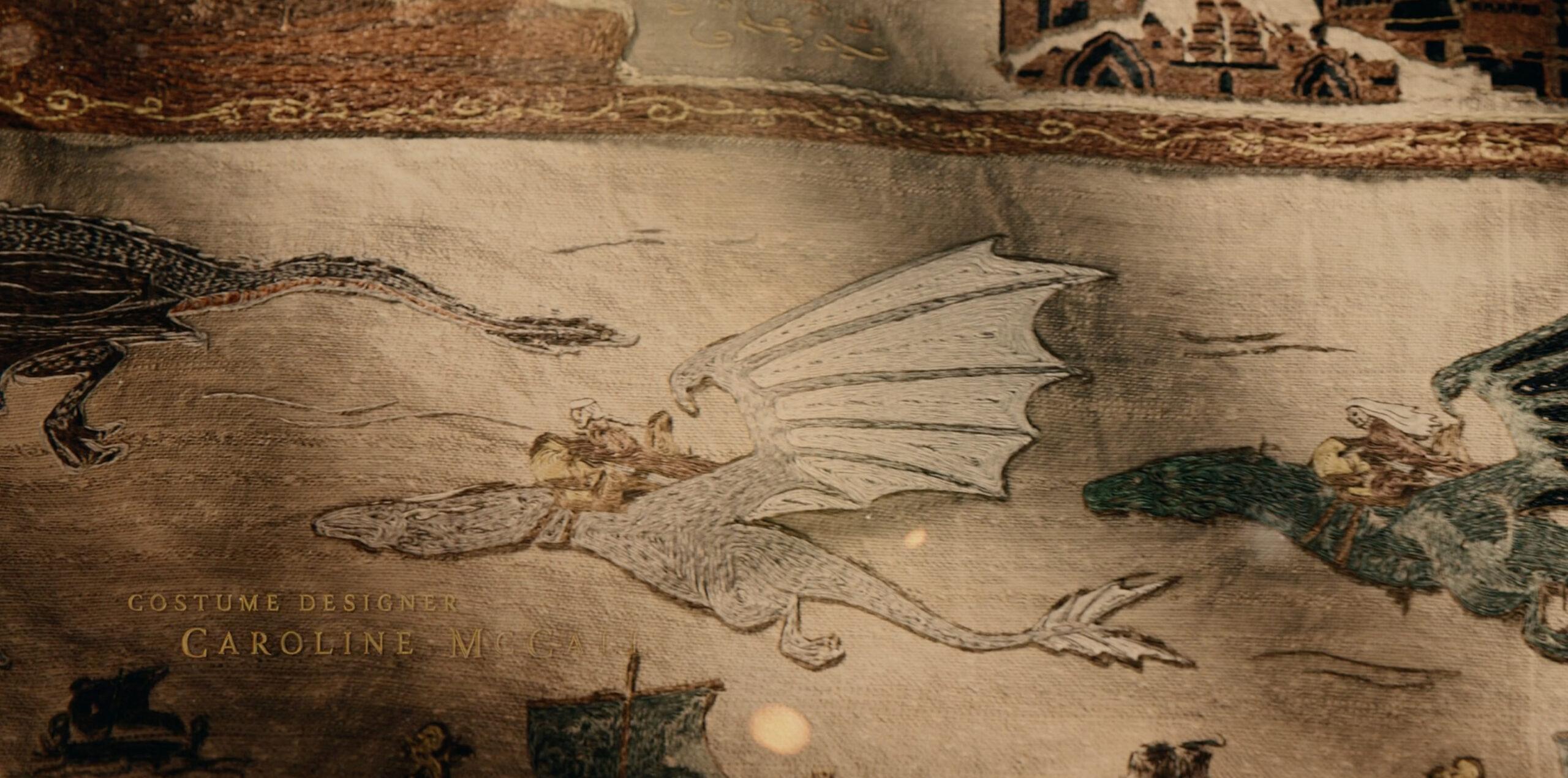
Here’s Aegon and Co. conquering Westeros. I’d assume this depicts his burning of Harrenhal:

The dragonfire prompted many of Westeros’s kings to surrender. On the left here is Sharra Arryn, ruling as regent for her son, Ronnel Arryn. Torrhen Stark is in the middle, and on the right is Edmyn Tully.

Skipping ahead, this image depicts the death of King Maegor, known as Maegor the Cruel. His bloody, horrible reign ended when he was found impaled on the Iron Throne. It was never discovered who killed him—some say it was the Throne itself.
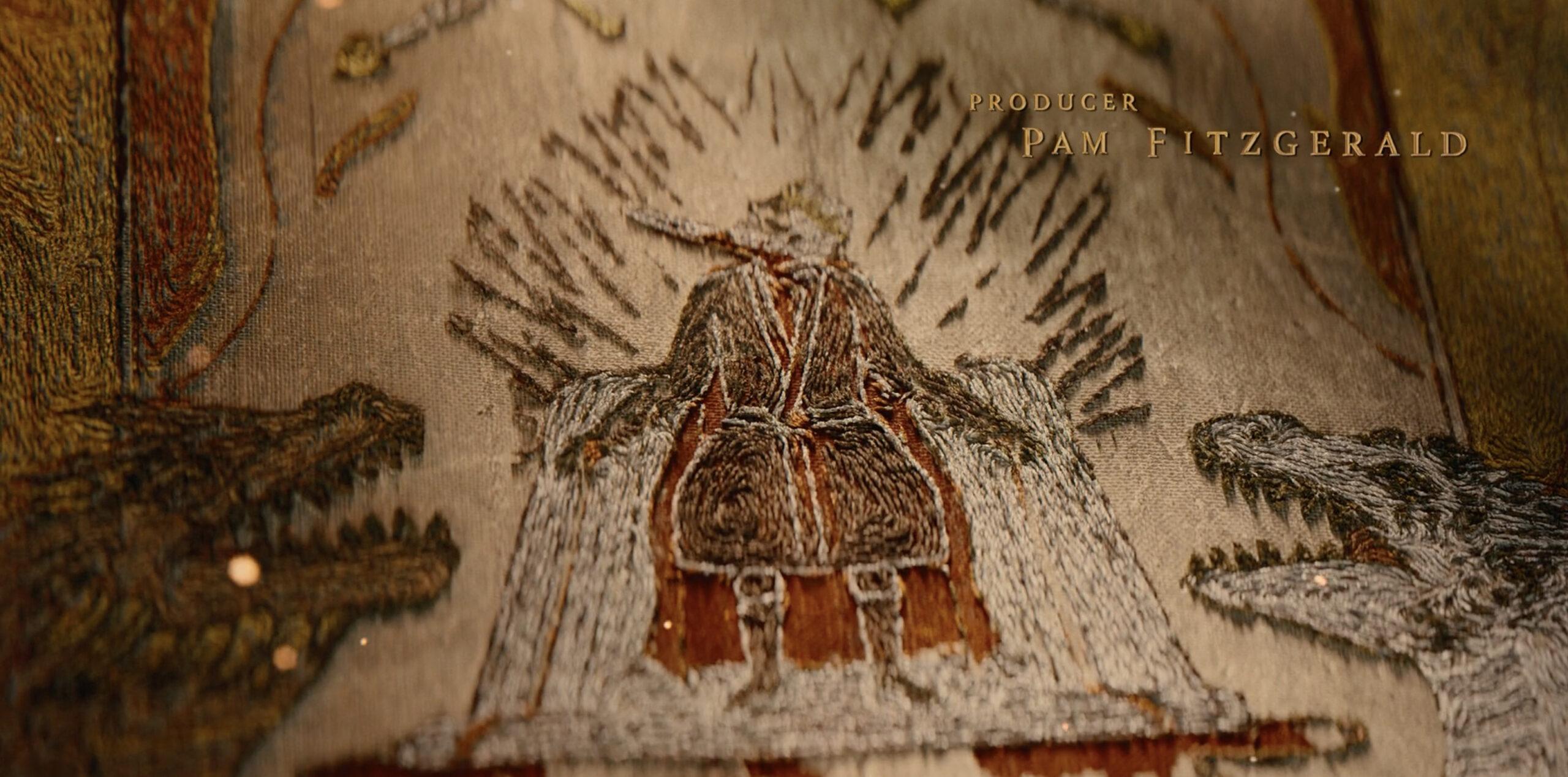
Following Maegor, Jaehaerys I ascended the throne. He ruled alongside his sister-wife, Alysanne, for 55 years, earning the monikers “the Conciliator,” “the Wise,” and “the Old King.”
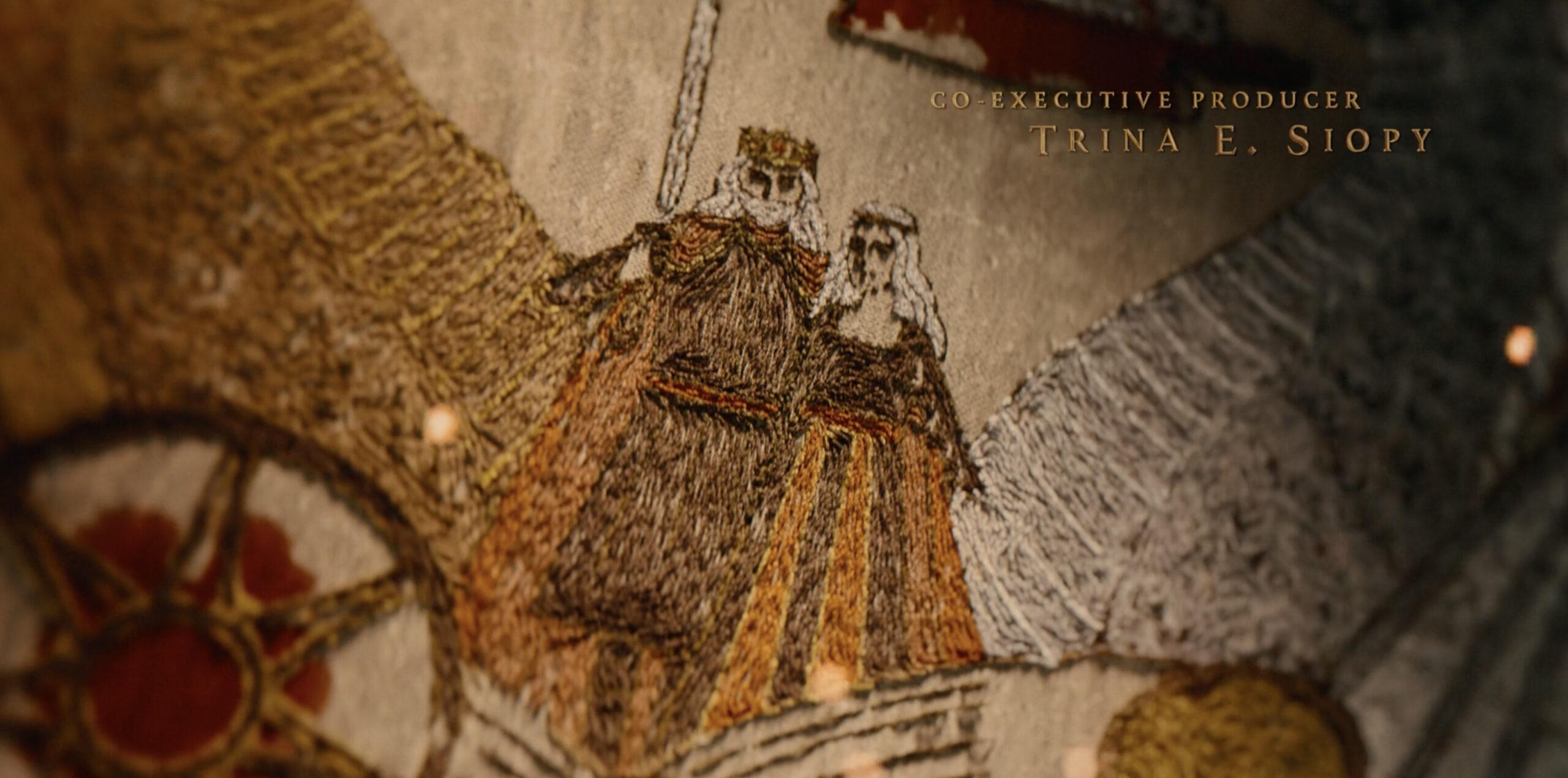
Here’s the Great Council of 101 AC, to find Jaehaerys’s successor.

Now we get the blacks and the greens on opposite sides:

King Aegon II:

And Queen Rhaenyra:
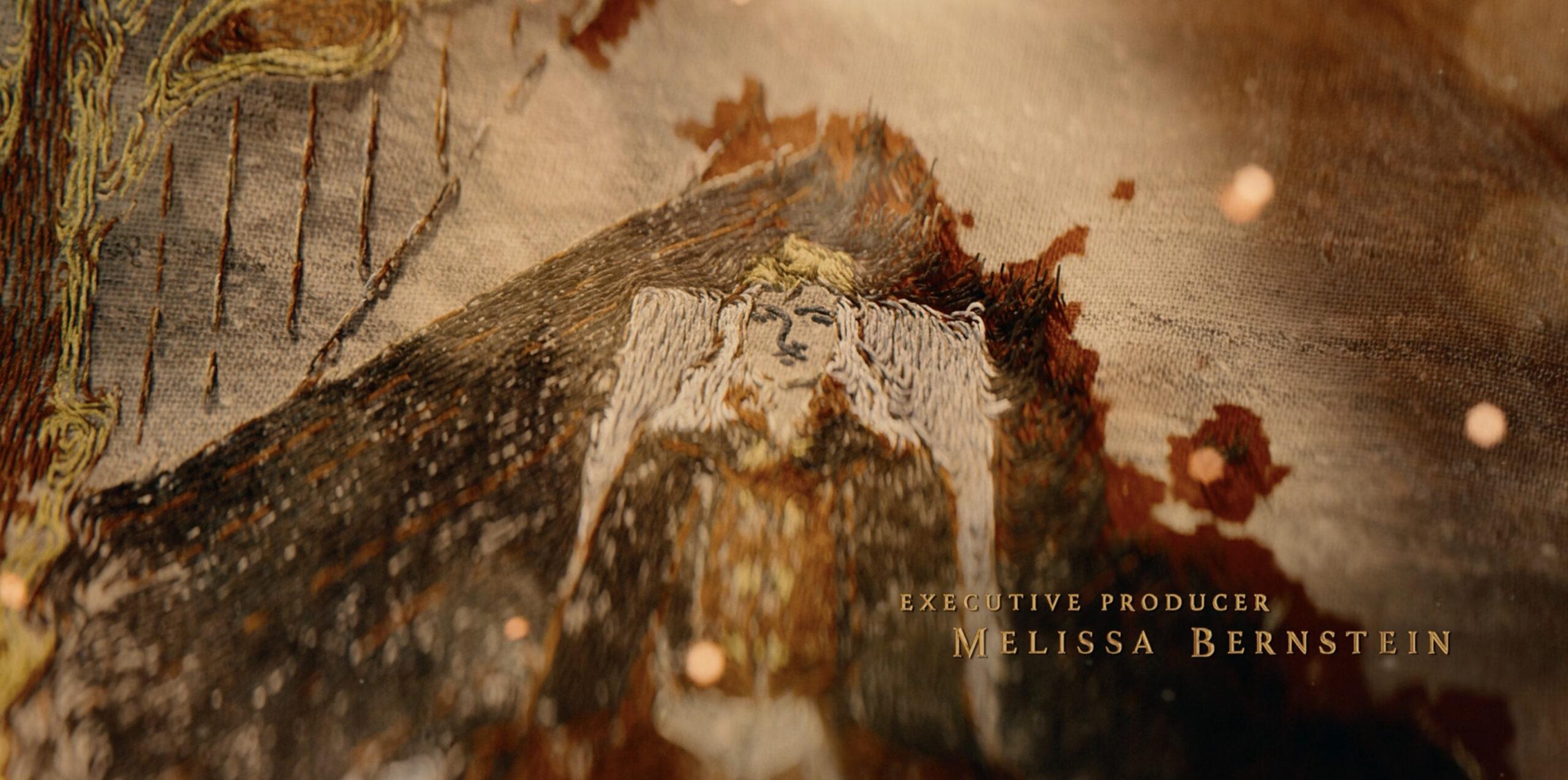
Here we get a green hand, sending ravens, and a black hand, sending two dragons:
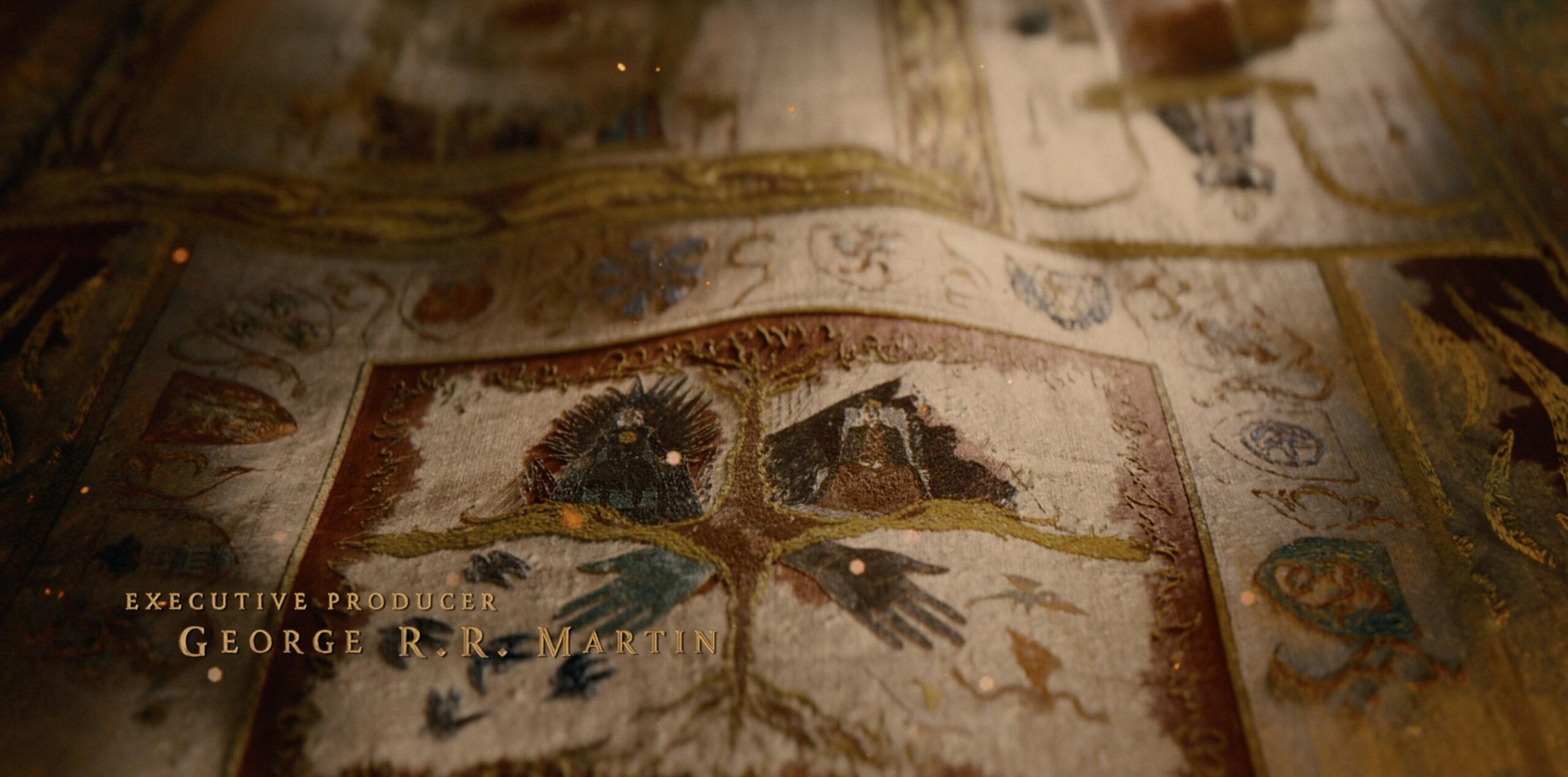
And finally, the death of Lucerys and Arrax at the claws and jaws of Vhagar:
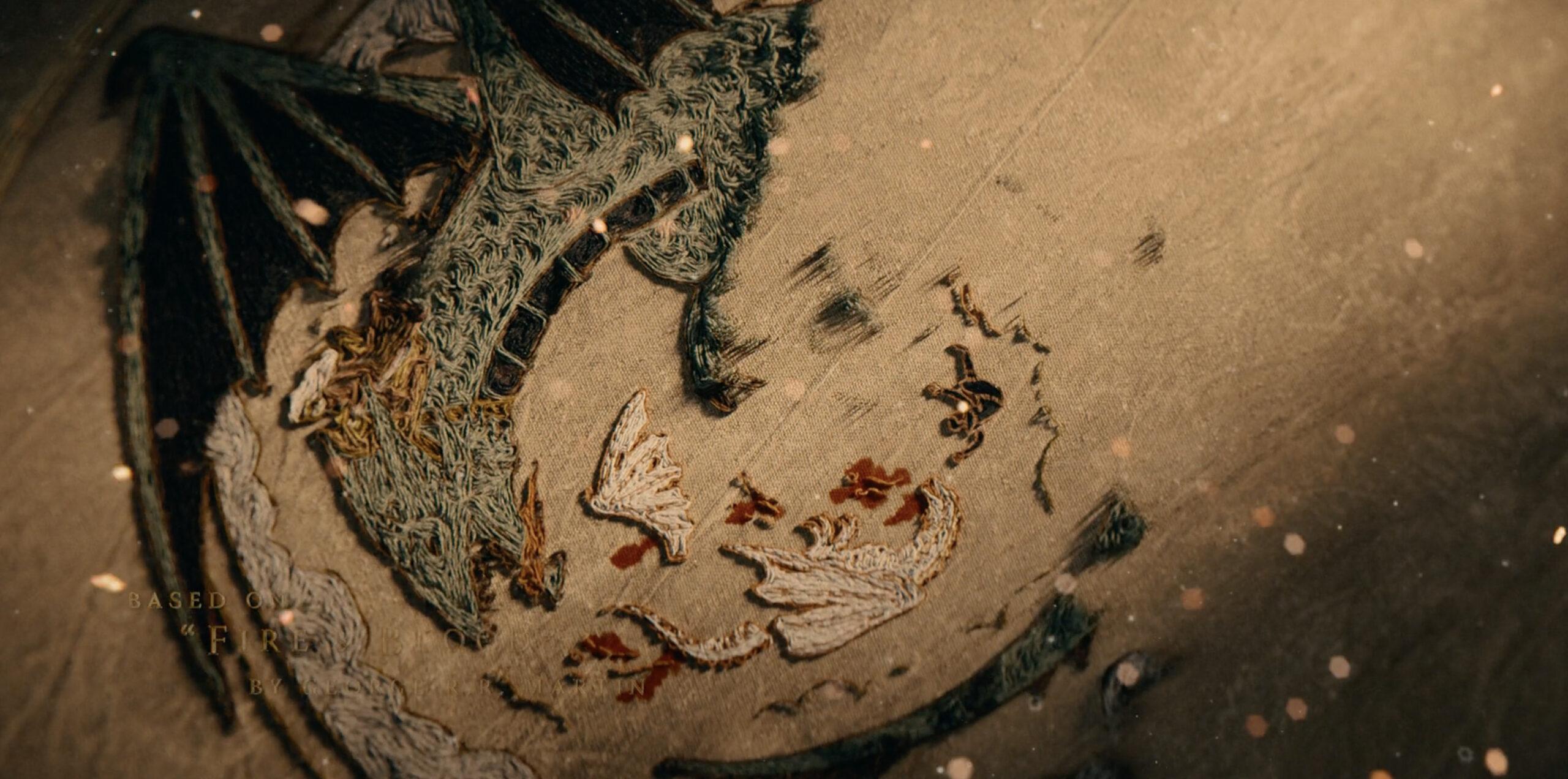
That pretty much catches us up to the current season. We’ll see whether subsequent seasons will fill in this tapestry with events from Season 2.
Magnanimous, Adjective [Mag·nan·i·mous]
- showing or suggesting a lofty and courageous spirit
- showing or suggesting nobility of feeling and generosity of mind
Aegon the Magnanimous? I think not. Lest we forget, this is the same Aegon who loves to participate in child-fighting rings—where they file the children’s teeth into points—and who raped a handmaiden in Season 1. Recall Aegon’s first words when he learned his father was dead and the greens wanted to crown him king: “I have no wish to rule! No taste for duty! I’m not suited!” Aegon the Unsuited has a nice ring to it.
Do They Teach History in the North?
I loved the scene with Jacaerys and Cregan at the Wall. What a delightful return to the edge of the world.
That said … Jace and Cregan got their history all jumbled. Jace begins by saying that their ancestors—Aegon the Conqueror and Torrhen Stark—“treated in this very place,” but this isn’t quite right. Torrhen Stark famously bent the knee to Aegon, but he did so at the Trident (roughly the same location where Robert Baratheon later kills Rhaegar Targaryen). Torrhen had a host of 30,000 men, but Aegon had 45,000 and three dragons, and he had already brought much of Westeros under his control. Rather than face certain slaughter, King Torrhen Stark surrendered to Aegon and became Lord Torrhen Stark, the King Who Knelt.
There’s never any mention of Aegon visiting the North, much less making it all the way to the Wall. This could be a bit of a retcon—one that would fit with the series’ emphasis on the dream that Aegon himself had of a wintry apocalypse coming to Westeros from the North (a prophecy that I’m 95 percent sure is also a retcon). But if Aegon conquered Westeros because of that dream, it would make sense for him to have visited the millennia-old, 700-foot-tall ice wall that blocks off access to the far North.
At any rate, Cregan goes on to say that his father brought both King Jaehaerys and Queen Alysanne to see the Wall. “His Grace stood at this very outlook and watched as their dragons, the greatest power in the world, refused to cross it,” Cregan says. But Fire & Blood is clear that only Alysanne visited the Wall—Jaehaerys was occupied in King’s Landing, and his journey to the North went only as far as Winterfell. Alysanne was so struck by the Night’s Watch that she doubled the size of the land given to them and agreed to pay for the construction of a new castle. (A different castle was renamed the Queensgate, after her.) Either the show is making a small tweak for simplification, or Cregan doesn’t know his history as well as he perhaps should.
The Mystery Northerner
We sure spend a lot of time on this mystery Northerner as Cregan Stark monologues about duty:
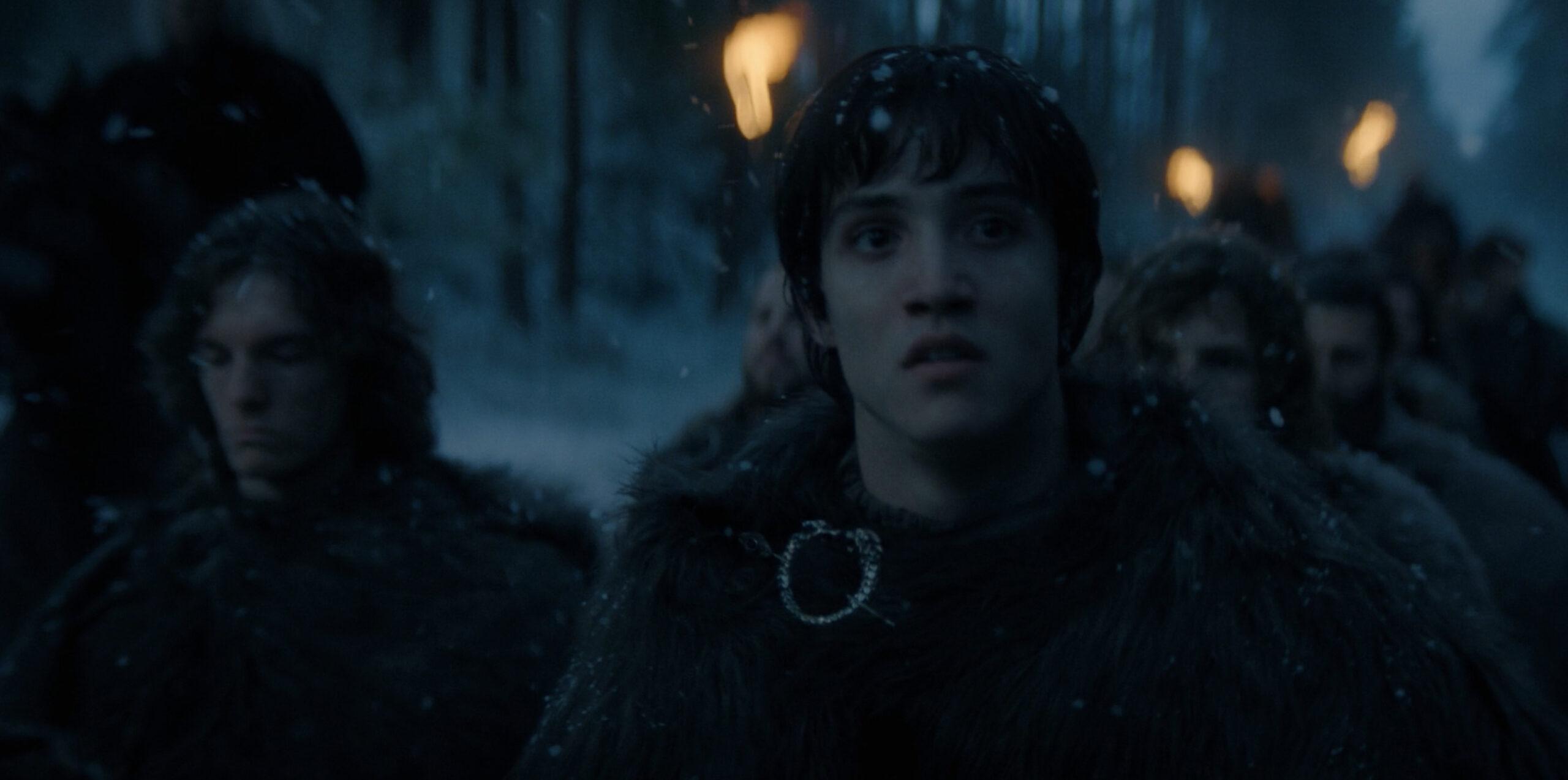
If you were wondering who this is, I don’t think it’s anyone important. Rather, this scene serves as a reminder that it isn’t just the dregs of Westerosi society that get sent to the Wall. Remember how Benjen Stark—Ned’s brother—was stationed at the Wall in Thrones?
Bad News for Our Boy Daeron
Book readers, green fans, and even Olivia Cooke herself eagerly want to know whether Alicent’s third son, the yet unseen Daeron, is part of the show or whether he’s been cut. Daeron, who rides the dragon Tessarion, was sent to Oldtown in his youth to serve as cupbearer to Ormund Hightower, Alicent’s cousin. He should be a teenager—the same age as Jacaerys. But Otto neglected to mention him when he detailed how Ormund would gather his host in Oldtown and begin moving east. That doesn’t bode well for Daeron’s inclusion in the story. And if the greens don’t have his dragon, the dragon math would pretty clearly favor the blacks.
The New Heir
With little Jaehaerys dead, the realm—well, the part of it that recognizes Aegon II—has lost its heir to the throne. Who is the new heir?
In Fire & Blood, this is simple. Aegon has two sons, and his youngest, Maelor, becomes his heir upon Jaehaerys’s death. HBO’s official character guide does not include Maelor (interestingly enough, it does include Daeron), and showrunner Ryan Condal confirmed the other brother’s omission in a post–Episode 1 interview. Book readers very much expected Maelor to appear in this episode, as in Fire & Blood, he is present for Jaehaerys’s murder. (In the book, Jaehaerys’s murder is even more dark. As my colleague Zach Kram detailed on Sunday, the two assassins—Blood and Cheese—ask Helaena which son she wants to keep, and she picks Jaehaerys. Cheese tells Maelor, “Your momma wants you dead,” and then spares him and kills Jaehaerys.)
With Maelor out of the picture, Aegon has no legitimate sons, and we have to go back up the family tree to find his heir. Next in line for the throne is now Aemond One-Eye. Aemond openly thinks he would be a better king than Aegon (the Aemond-Daemon parallels continue!). Remember his first words to Aegon after Viserys’s death? “I was hoping you disappeared.” Not that Aemond would plot to overthrow his brother—as Aegon says this week, Aemond is his closest blood—but it does make for a bit of an awkward situation.
Next Time On …
HBO released a video previewing “the weeks ahead” following Sunday’s premiere. I can’t wait to find out what compels Criston to get this haircut:


